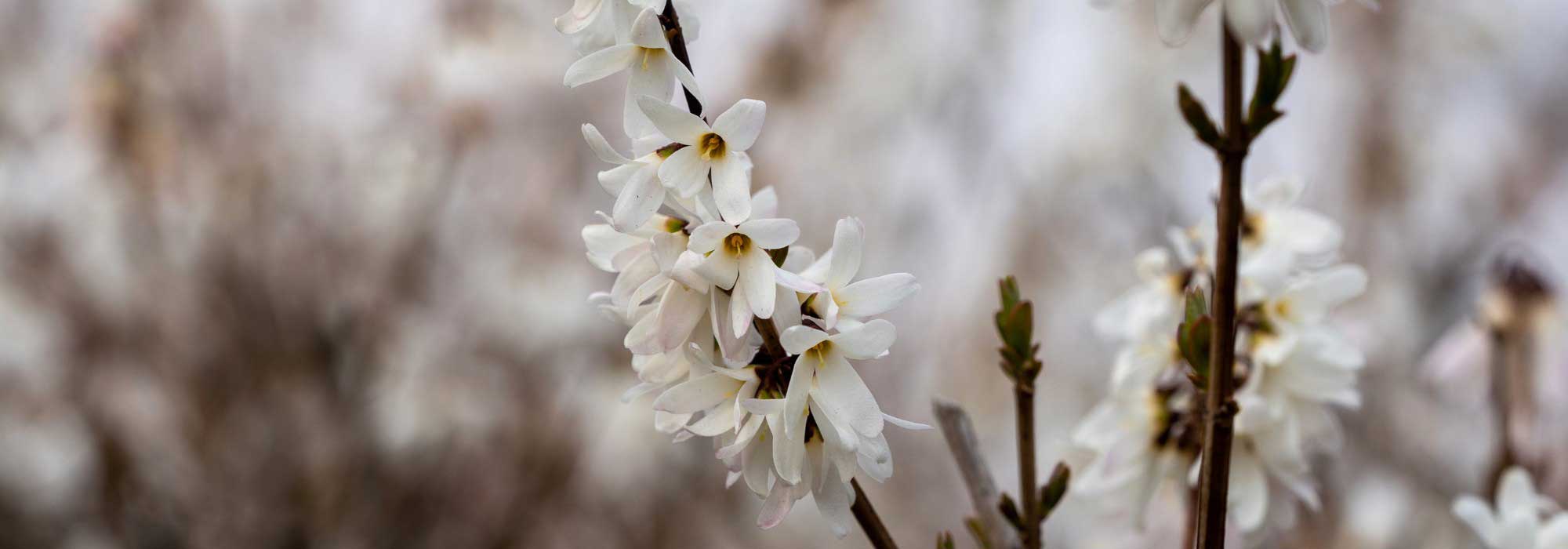
Abeliophyllum: planting, growing and care
Contents
Abeliophyllum in a nutshell
- Abeliophyllum is one of the first bushes to flower in late winter
- It heralds the return of fine weather with its elegant white or pink flowering
- It’s a beautiful alternative to the very common Forsythia
- Easy to grow, this is an accommodating and hardy bush
- It can be grown as a hedge, in a flower bed, as a standalone plant, or in a large pot or container on the terrace
The word from our expert
Abeliophyllum distichum, or Korean Forsythia, is a lesser-known ornamental bush that nevertheless deserves a prime spot in our gardens for its early and delicate flowering. This is a deciduous, bushy bush, reaching approximately 1.50 to 2 metres in all directions. Very similar to forsythias, the Abeliophyllum also flowers in late winter, typically in February-March, but distinguishes itself with its white flowering, or even pink for the variety Abeliophyllum distichum ‘Roseum’. Its flowers appear on the naked branches before the leaves develop. They are delicately scented and attract pollinating insects. The Abeliophyllum bears fairly ordinary foliage, dark green, ovate, and slightly dentate, but it takes on beautiful autumn colours, ranging from yellow to red.
Abeliophyllum is an easy-to-grow and low-maintenance plant, perfectly suited for beginner gardeners. It is hardy (down to -20°C), resistant to diseases and parasites, and adapts to various types of soil. In the garden, it can be planted in a hedge, as a standalone feature in the middle of a short grass meadow, or at the back of a flower bed. It also adapts well to cultivation in a large pot or container. The Abeliophyllum is ideal for accompanying the early flowering of forsythias, witch hazels, flowering currants, and Japanese quinces, as well as spring-flowering bulbs like crocuses, ipheions, and snowflakes. Discover all our tips for successfully growing the Abeliophyllum and integrating it seamlessly into your garden!
Botany
Botanical data
- Latin name Abeliophyllum distichum
- Family Oleaceae
- Common name Korean white forsythia
- Flowering February to March
- Height 1.50 m to 2 m
- Exposure Sun, partial shade
- Soil type ordinary, fresh and well-drained, acidic or neutral
- Hardiness -20 °C
Abeliophyllum, also known as Korean white forsythia, is a deciduous and bushy bush native to the mountains of South Korea. It grows naturally on rocky slopes and wooded areas, where it benefits from well-drained soil and sunny exposure. It was introduced to Europe and North America in the early 20th century, but it is still relatively uncommon in gardens, despite its great ornamental qualities. Today, it is endangered in its natural habitat; indeed, only about ten individuals remain in the wild.
Abeliophyllum lives up to its name as Korean forsythia, as it closely resembles forsythia and is botanically very similar. These two bushes belong to the same family, that of the olive tree, the Oleaceae. This family also includes jasmine and lilac. Abeliophyllum comprises only one species (A. distichum), but there is another variety, distinguished by its pastel pink flowers: Abeliophyllum distichum ‘Roseum’.
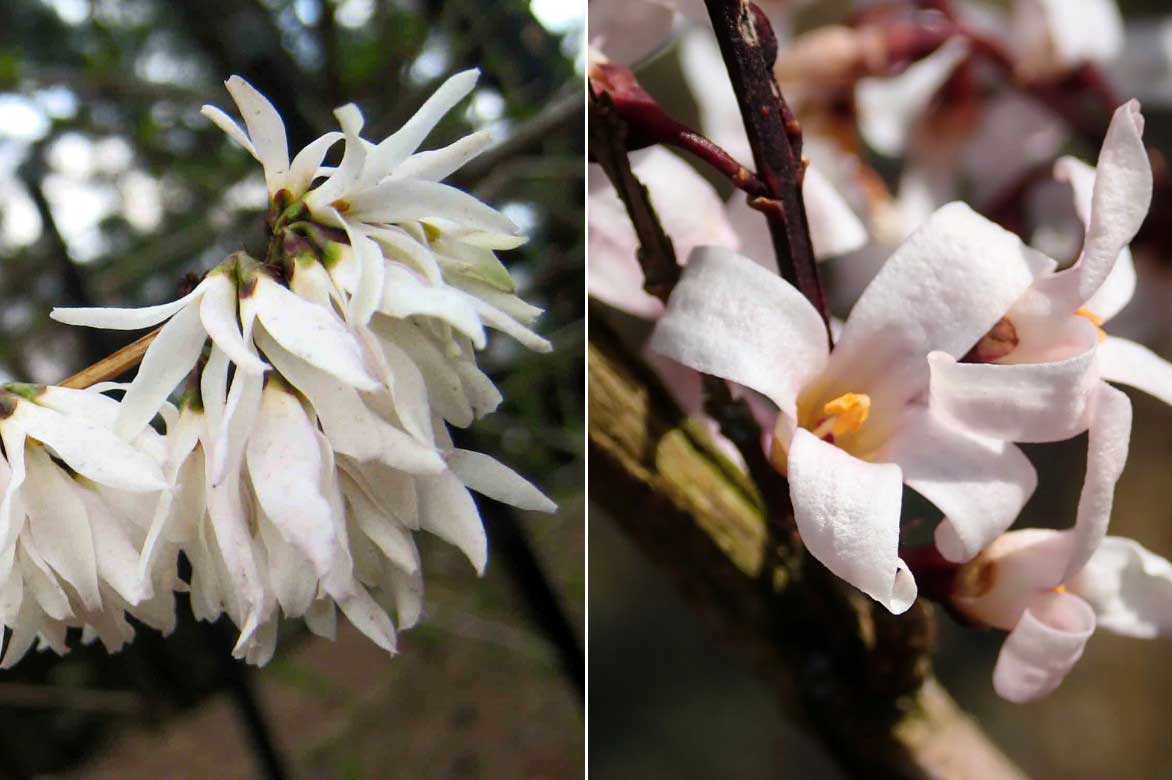
The flowering of Abeliophyllum
Abeliophyllum distichum is a bush with a bushy and slightly spreading habit, quite low-growing. It reaches between 1.5 and 2 m in all directions. Its slender, arching branches give it an elegant and graceful appearance. This light structure makes it easy to integrate into various types of gardens, from flower beds to borders, and even low hedges.
Abeliophyllum flowers very early in the year, in February-March, before the foliage appears. Just like forsythia, Abeliophyllum heralds the end of winter and the arrival of brighter days! It bears beautiful white flowers, or even pale pink in the case of the variety Abeliophyllum distichum ‘Roseum’. The flowers are small, measuring 1 to 1.5 cm in diameter, and are clustered on the branches in small groups of 3 to 5 flowers. They consist of 4 white or pink petals and are highlighted by an orange-yellow centre. They release a pleasant almond fragrance. At the end of flowering, the flowers take on a light brown hue. Abeliophyllum is a beautiful alternative for those who dislike the bright yellow, garish flowering of the very common forsythia.
The flowering of Abeliophyllum is melliferous, appreciated by pollinating insects at a time when flowers are still scarce.
After flowering, Abeliophyllum develops its foliage. Its leaves are dark green, slightly glossy, ovate to oblong, with edges that are sometimes slightly dentate. They measure 5 to 10 cm in length. They are opposite and arranged in two ranks, which is why it is named distichum, from the Greek dis: “two,” and stikhos: “row.” In autumn, the leaves turn shades ranging from golden yellow to purplish red, adding a lovely splash of colour to the garden before they fall.
Abeliophyllum is a relatively slow-growing plant. Once established, it requires little intervention, apart from light pruning to maintain its shape and encourage abundant flowering. In the garden, Abeliophyllum can be used as a standalone feature, for example in the middle of a short grass meadow, which will highlight it particularly well, or in combination with other bushes that flower at the same time (forsythia, witch hazel, Japanese quince…) and with spring bulbs. Its early flowering makes it an excellent choice to brighten gardens at the end of winter, while its foliage and elegant habit provide a discreet but charming presence throughout the growing season.
Abeliophyllum tolerates temperatures as low as -20 °C. However, in regions with particularly harsh winters, it is recommended to plant it in sheltered locations, such as against a south-facing wall, to benefit from residual warmth and protection from cold winds.
Abeliophyllum is also appreciated as a cut flower for creating bouquets. In the same way as forsythia, you can cut a few branches in early December and place them in a vase: they will bloom by Christmas. Discover our tutorial: “How to force forsythia branches for bright and colourful bouquets?”
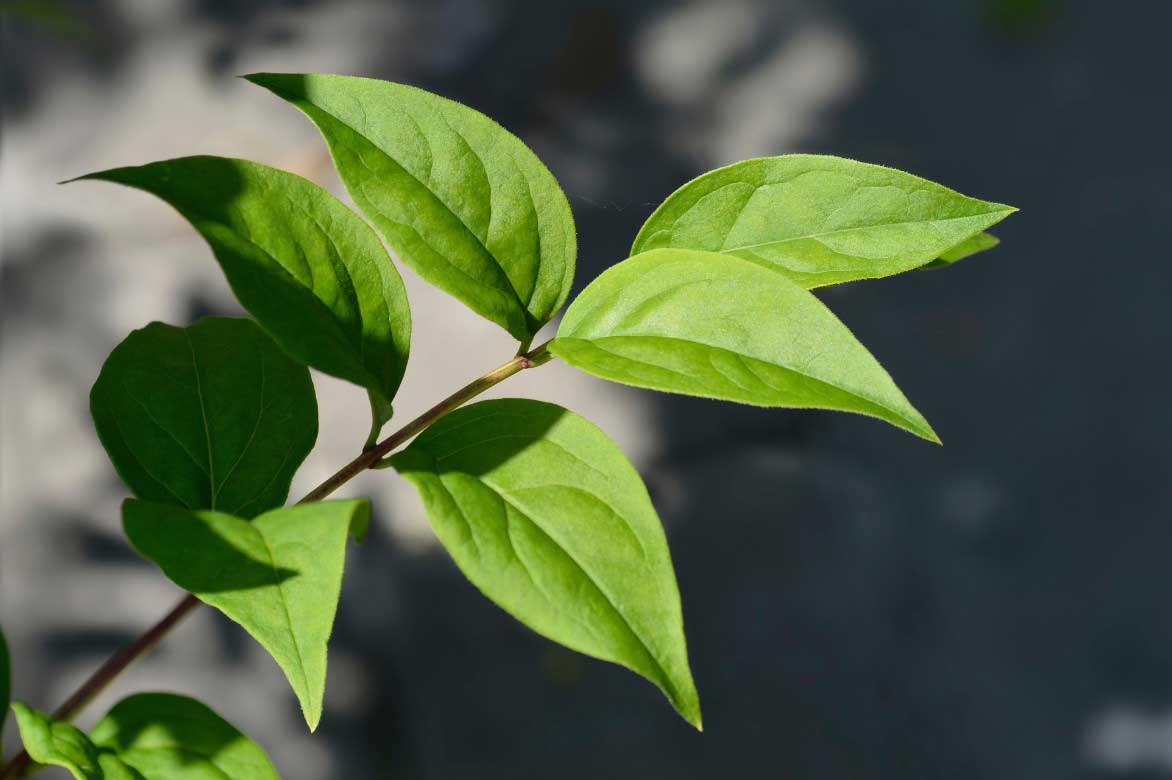
The foliage of Abeliophyllum
The main varieties of Abeliophyllum
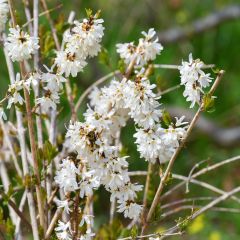
Abeliophyllum distichum - White Forsythia
- Flowering time March, April
- Height at maturity 1,50 m
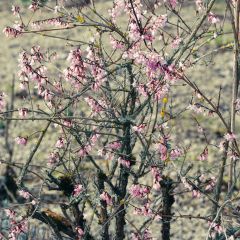
Abeliophyllum distichum Roseum
- Flowering time March, April
- Height at maturity 1,50 m
Planting
Where to plant Abeliophyllum?
Abeliophyllum prefers a sunny or lightly shaded location. Good sunlight encourages abundant flowering. In the southern regions of France, where summers are very hot, light shade in the afternoon will be beneficial to avoid water stress. We also recommend planting Abeliophyllum in a sheltered spot, protected from strong winds, such as near a wall or hedge.
This bush is tolerant of soil type but prefers fertile, moist, well-drained soils, slightly acidic to neutral. Heavy or poorly drained soils can lead to root rot. We advise enriching the soil with compost before planting.
In the garden, Abeliophyllum can be placed in a free and rustic hedge, in a shrub border, as a standalone feature, or trained against a wall. It can even be grown in a large container on a balcony or terrace.
When to plant?
The ideal time to plant Abeliophyllum is in autumn, between October and November, allowing it to establish before winter, develop a robust root system, and be ready to grow the following spring. However, it can also be planted in early spring, before the growing season resumes. Avoid periods of frost or extreme heat.
How to plant Abeliophyllum?
In the ground
If planting multiple young plants (e.g., for a hedge), space them 1.5 to 2 metres apart.
- Start by placing the root ball in a basin of water to rehydrate it.
- Loosen the soil to a depth of 30 to 40 cm and incorporate well-rotted compost.
- Dig a hole twice as wide and deep as the bush’s root ball.
- Place the bush in the centre of the planting hole, ensuring the top of the root ball is level with the soil.
- Fill the hole with the excavated soil and lightly firm it down.
- Water thoroughly to help the plant settle. Consider creating a watering basin around the base to aid water infiltration.
- You can also apply a layer of organic mulch around the base of the bush. This will help retain soil moisture and suppress weeds.
For the first few weeks, water regularly to keep the soil moist but not waterlogged. Monitor the young plants closely for signs of water stress, diseases, or parasitic issues. Regular checks allow for quick action if problems arise, ensuring healthy growth.
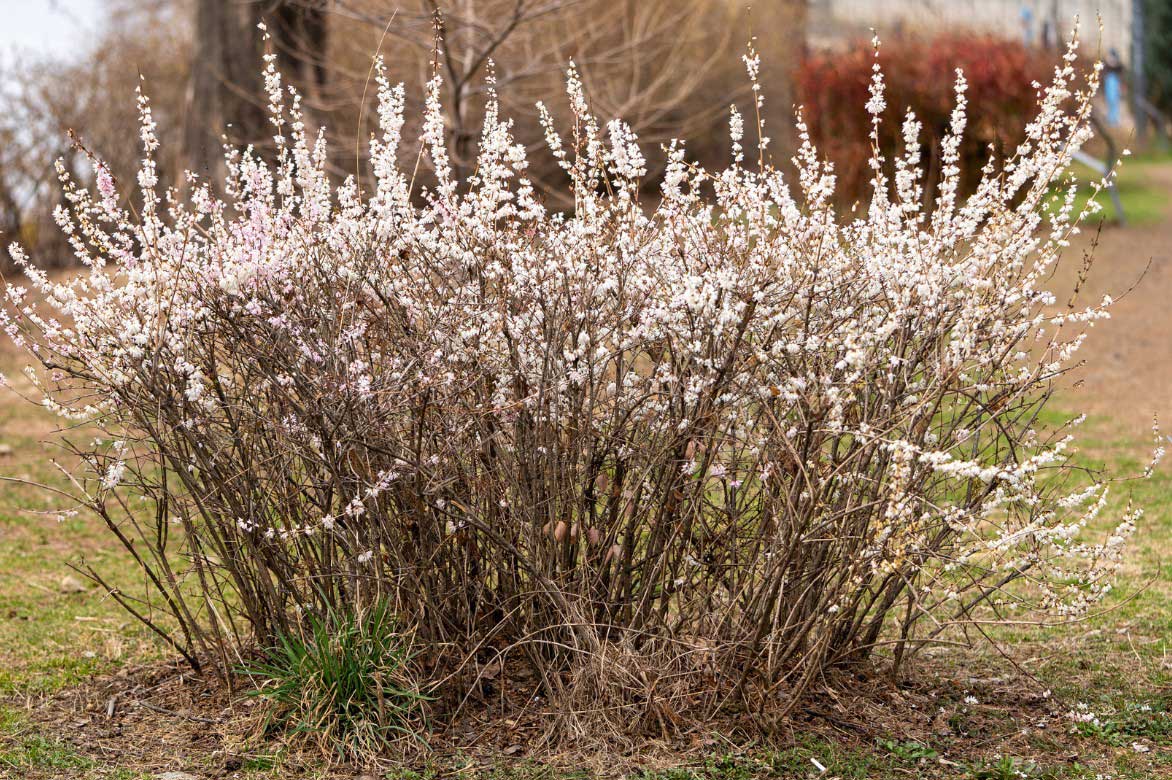
In a pot
- Use a pot at least 40 cm in diameter with drainage holes.
- Fill the pot with a mix of garden soil, compost, and sand.
- Place the root ball in the pot, then fill with substrate and lightly firm it down. Ensure the top of the root ball is level with the substrate to prevent water pooling around the crown.
- Water thoroughly.
- Position the pot in a sunny or lightly shaded spot. During extreme heat, move it to a shaded area to protect the bush.
Care
The Abeliophyllum is an accommodating, hardy bush with little susceptibility to diseases and parasites. It therefore requires minimal maintenance once planted in the garden.
However, we recommend pruning it annually, around April, as soon as it has finished flowering. This will encourage abundant flowering and vigorous growth. Pruning is done in spring rather than autumn to avoid compromising the following year’s flowering, as the bush blooms on the previous year’s wood.
For the first few years, only very light pruning is necessary, primarily removing dead, diseased, or damaged branches, and thinning out the interior of the bush slightly to improve air circulation and light penetration. In subsequent years, you can prune more severely by shortening its branches by a third or half their length. This will rejuvenate the bush and encourage the formation of new floriferous branches while maintaining a compact and balanced shape.
The Abeliophyllum prefers slightly moist soil, especially during the first few years after planting and during dry spells. Water regularly for the first two years to help establish a strong root system. Ensure the soil remains moist but not waterlogged. Once well-rooted, the bush tolerates drought better, but occasional watering during periods of intense heat or prolonged dryness will benefit it. We also recommend applying a layer of organic mulch around its base to keep the soil cool for longer and suppress weed growth.
In spring, apply a balanced organic fertiliser or well-rotted compost around the base of the bush to provide the nutrients needed for its growth.
How to propagate Abeliophyllum?
Abeliophyllum can be propagated by propagation by cuttings or layering. The seeds have a relatively low germination rate, which is why we do not recommend sowing.
Propagation by cuttings
Propagation by cuttings is carried out in late summer, around August, when the new shoots of the year are partially lignified (semi-hardwood).
- Choose healthy shoots from the current year. Take cuttings 10 to 15 cm long by making a clean cut below a node.
- Remove the leaves from the lower part of the cuttings, leaving only a few at the top.
- Dip the base of the cuttings in plant hormone to stimulate rooting (facultative).
- Prepare pots by filling them with a mixture of compost and sand, and water to moisten the substrate.
- Plant the cuttings in the substrate, and gently firm the soil around them.
- Place the pots in a mini greenhouse or cover them with a transparent plastic bag to maintain high humidity. Ensure the bag does not touch the leaves to avoid direct condensation.
- Place the cuttings in a bright location, but out of direct sunlight. Keep the substrate moist, but not waterlogged.
- Once the cuttings have developed sufficient roots (usually after 2 to 3 months), you can transplant them into larger pots. Wait until the following spring or autumn to plant them in the ground.
Layering
Layering of Abeliophyllum is also done in late summer. This technique involves burying a low branch of the bush so that it develops roots before being separated from the parent plant.
- Choose a low and flexible branch.
- Make a slight incision on the branch where it will come into contact with the soil to encourage rooting.
- Bury this part of the branch in the soil, leaving the tip free. Secure it with a stone or a hook.
- Keep the soil moist and wait several months for roots to develop.
- Once strong roots have formed, cut the branch from the parent plant and transplant it to its permanent location.
How to pair it?
In the garden, you can incorporate Abeliophyllum into a mixed hedge alongside other bushes that flower in late winter or early spring, such as forsythias, Japanese quinces, flowering currants, witch hazels, and Edgeworthia chrysantha. Consider the delicate pink flowers of the winter viburnum, Viburnum farreri, and enjoy the elegant flowering of camellias. You can also plant alongside it dogwoods with coloured wood, Magnolia stellata, and flowering cherries. To create a green backdrop year-round, include a few evergreen bushes, such as holly and sarcococca.
Don’t hesitate to plant small spring bulbs at the base of the Abeliophyllum, like crocuses, botanical tulips, ipheions, and snowflakes (Leucojum vernum), as well as early-flowering perennials, such as hellebores, Eranthis hyemalis, Anemone nemorosa, and Cyclamen coum. Think of winter heathers (Erica darleyensis), which brighten the garden in winter with their countless tiny white or pink bells. Highlight these blooms by surrounding them with the decorative foliage of carex and heucheras.
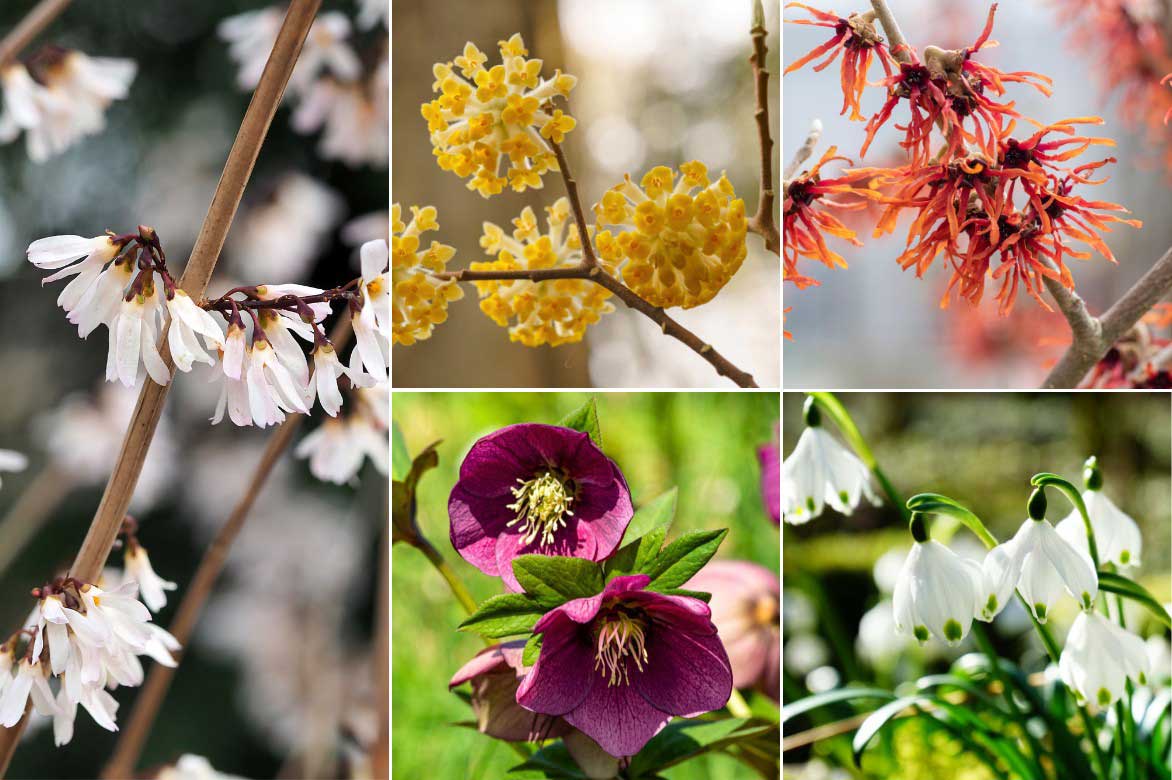
Abeliophyllum distichum, Edgeworthia chrysantha, Hamamelis intermedia, Helleborus orientalis and Leucojum vernum
Useful resources
- Discover our range of winter-flowering shrubs
- All our white-flowering shrubs
- Pairing Abeliophyllum or white Forsythia from Korea: our ideas!
- Subscribe!
- Contents
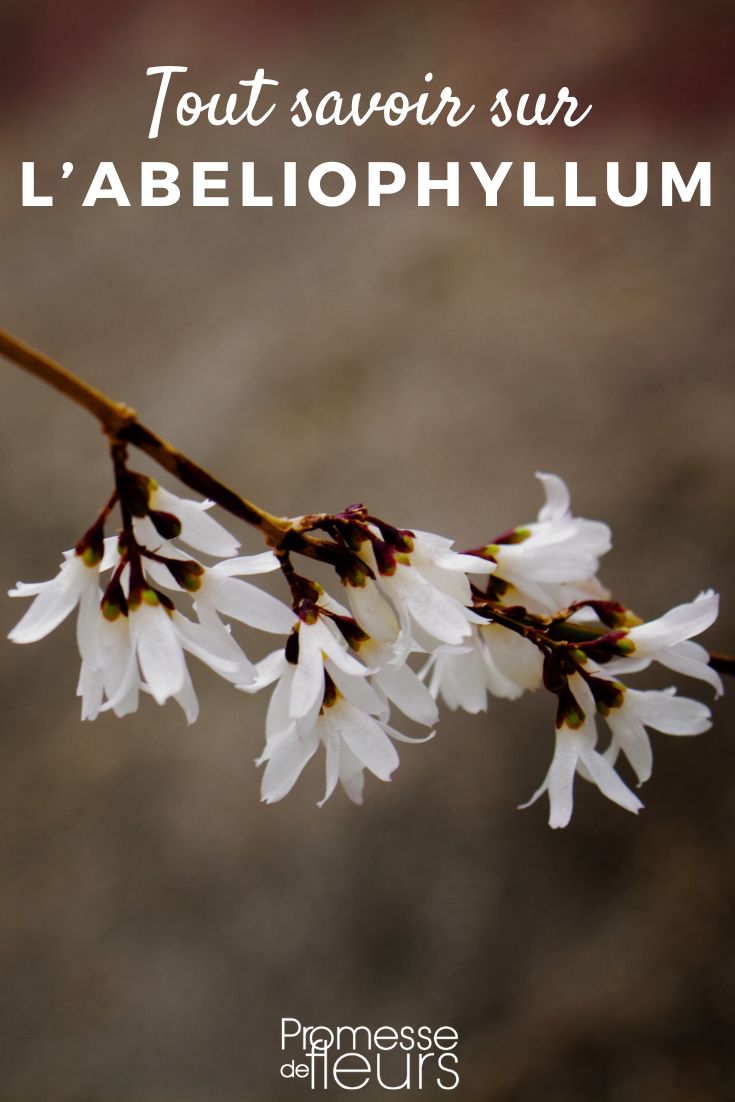































Comments